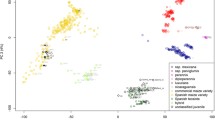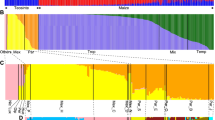Abstract
Isozyme variation in 94 accessions of Mexican maize (Zea mays ssp. mays) and 37 collections of Mexican annual teosinte (Z. mays ssp. mexicana and var. parviglumis) are compared. Variety parviglumis (a predominantly wild plant) shows a closer genetic relationship to maize than does ssp. mexicana (a weedy teosinte often found in maize fields). The isozyme data suggest that maize and Z. mays var. parviglumis share a more recent common ancestor than either of these taxa share with other members of the genus Zea. In this sense, the isozyme data support the theory that maize is a domesticated form of teosinte. Isozyme data provide no evidence for independent origin of Mexican maize races from different taxa of teosinte. Isozyme analysis suggests that gene flow between maize and ssp. mexicana exists, but that it is highly restricted and more probably goes from weed into crop. Maize and var. parviglumis are isozymically too similar and too variable to allow patterns of gene flow between them (if any) to be discerned. The maize- teosinte complex does not fit a model applied to some other crops in that (I) weedy teosinte (ssp. mexicana) does not appear to be a hybrid of the wild form (var. parviglumis,) and maize and (2) the weedy form does not act as a genetic bridge between wild form and crop.
Similar content being viewed by others
Literature Cited
Barrett, S. C. H. 1983. Crop mimicry in weeds. Econ. Bot. 37:255–282.
Beadle, G. W. 1980. The ancestry of corn. Sci. Amer. 242:112–119.
Bird, R. M. 1980. Maize evolution from 500 B.C. to the present. Biotropica 12:30–41.
Cardy, B. J., C. W. Stuber, and M. M. Goodman. 1980. Techniques for starch gel electrophoresis of enzymes from maize (Zea mays L.). Inst. of Statistics Mimeo Series 1317, North Carolina State Univ., Raleigh, NC.
Collins, G. N. 1921. Teosinte in Mexico. J. Heredity 12:339–350.
de Wet, J. M. J. 1975. Evolutionary dynamics of cereal domestication. Bull. Torrey Bot. Club 102: 307–312.
—, J. R. Harlan, and C. A. Grant. 1971. Origin and evolution of teosinte (Zea mexicana (Schrad.) Kuntze). Euphytica 20:255–265.
Doebley, J. F. 1983. The maize and teosinte male inflorescence: a numerical taxonomic study. Ann. Missouri Bot. Gard. 70:32–70.
—. 1984. Maize introgression into teosinte—a reappraisal. Ann. Missouri Bot. Gard. 71:1100–1113.
—, M. M. Goodman, and C. W. Stuber. 1983. Isozyme variation in maize from the southwestern United States: taxonomic and anthropological implications. Maydica 28:94–120.
—,—, and —. 1984. Isozyme variation inZea (Gramineae). Syst. Bot. 9:203–218.
—,—, and —. 1985. Isozyme variation in the races of maize from Mexico. Amer. J. Bot. 72:629–639.
Galinat, W. C. 1973. Preserve Guatamalan teosinte, a relict link in corn’s evolution. Science 180: 323.
—. 1983. The origin of maize as shown by key morphological traits of its ancestor, teosinte. Maydica 28:121–138.
Goodman, M. M., and C. W. Stuber, 1983a. Races of maize. VI. Isozyme variation among races of maize in Bolivia. Maydica 28:169–187.
—, and —. 1983b. Maize.In S.D. Tanksley and T.J. Orton, eds., Isozymes in plant genetics and breeding, Part B., p. 1–33. Elsevier, Amsterdam.
Harlan, J. R. 1975. Crops and man. Amer. Soc. Agronomy, Madison, WI.
Heiser, C. 1973. Introgression re-examined. Bot. Rev. 39:347–366.
Iltis, H. H. 1983. From teosinte to maize: the catastrophic sexual transmutation. Science 222:886- 894.
—, and J. F. Doebley. 1980. Taxonomyof Zea (Gramineae). II. Subspecific categories in theZea mays complex and a genetic synopsis. Amer. J. Bot. 67:994–1004.
Kato, T. A. 1976. Cytological studies of maize. Massachusetts Agric. Exper. Sta. Bull. 635.
—. 1984. Chromosome morphology and the origin of maize and its races. Evol. Biol. 17:219- 253.
Ladizinsky, G. 1985. Founder effect in crop plant evolution. Econ. Bot. 39:191–199.
Mangelsdorf, P. C. 1974. Corn: its origin, evolution and improvement. Harvard Univ. Press, Cambridge, MA.
—, and W. C. Galinat. 1964. The tunicate locus in maize dissected and reconstituted. Proc. Natl. Acad. U.S.A. 51:147–150.
McClintock, B. 1959. Chromosome constitutions of Mexican and Guatemalan races of maize. Annual Rep. Dept. Genet. Carnegie Inst. Washington 59:461–472.
Randolph, L. F. 1959. The origin of maize. Indian J. Genet. Pl. Breed. 19:1–12.
Smith, J. S. C, M. M. Goodman, and C. W. Stuber. 1984. Variation within teosinte. III. Numerical analysis of allozyme data. Econ. Bot. 38:97–113.
—,—, and. 1985. Relationships between maize and teosinte of Mexico and Guatemala: numerical analysis of allozyme data. Econ. Bot. 39:12–24.
Stuber, C. W., and M. M. Goodman. 1983. Allozyme genotypes for popular and historically important inbred lines of corn,Zea mays L. U.S.D.A. Agric. Res. Results, Southern Series 16, New Orleans, LA.
Timothy, D. H., C. S. Levings, D. R. Pring, M. F. Conde, and J. L. Kermicle. 1979. Organelle DNA variation and systematic relationships in the genusZea: teosinte. Proc. Natl. Acad. U.S.A. 76: 4220–4224.
Wilkes, H. G. 1967. Teosinte: the closest relative of maize. Bussey Inst, Harvard Univ., Cambridge, MA.
—. 1970. Teosinte introgression in the maize of the Nobogame valley. Bot. Mus. Leafl. 22:297- 311.
—. 1977. Hybridization of maize and teosinte, in Mexico and Guatemala and the improvement of maize. Econ. Bot. 31:254–293.
Author information
Authors and Affiliations
Additional information
Paper No. 10479 of the Journal Series of the North Carolina Agricultural Research Service, Raleigh.
Rights and permissions
About this article
Cite this article
Doebley, J., Goodman, M.M. & Stuber, C.W. Patterns of isozyme variation between maize and Mexican annual teosinte. Econ Bot 41, 234–246 (1987). https://doi.org/10.1007/BF02858971
Received:
Accepted:
Issue Date:
DOI: https://doi.org/10.1007/BF02858971




